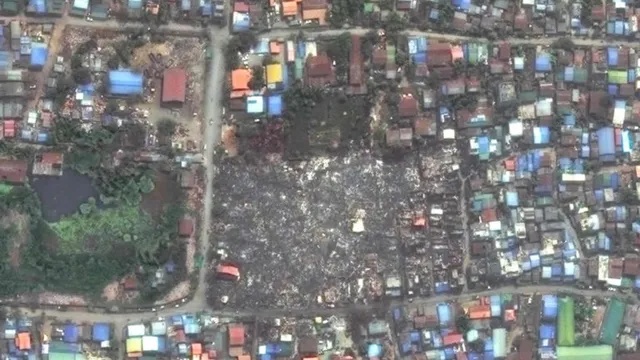- By Priyanka Koul
- Sun, 30 Mar 2025 03:58 PM (IST)
- Source:JND
Myanmar continues to grapple with the aftermath of a powerful 7.7 magnitude earthquake that struck on Friday, leaving over 1,600 dead, 3,400 missing, and more than a million people displaced. However, Myanmar’s State Administration Council confirmed on Saturday 139 remained missing till late Saturday night. The death toll is expected to rise as relief efforts continue.
As rescue operations continue, a 5.1 magnitude aftershock hit the region on Sunday, though no immediate reports of additional damage have surfaced.
The epicenter was just 20 km from Mandalay, a city of over 1.7 million people. The earthquake caused widespread destruction, reducing buildings to rubble and damaging key infrastructure, including roads and bridges. The disaster severely impacted Sagaing, Mandalay, Magway, Shan State, Nay Pyi Taw and Bago regions, prompting a state of emergency declaration.

Image Credits: Reuters
Extent of Destruction Captured in Satellite Images
New satellite images have revealed the widespread destruction, including a collapsed bridge and a damaged control tower at Nay Pyi Taw International Airport. The United Nations has reported that the earthquake has severely impacted critical infrastructure, with damaged airports, highways, and bridges slowing down the delivery of humanitarian aid.
In Mandalay, one of Myanmar’s largest cities, thousands of residents were forced to sleep on the streets, having lost their homes in the disaster. Local reports indicate minimal government presence, with relief efforts largely being carried out by volunteers and local organizations.
Severe Shortage of Medical Supplies, 3.5 million displaced
The UN Office for the Coordination of Humanitarian Affairs (OCHA) has warned that relief efforts are being hindered by a severe shortage of medical supplies. Hospitals are struggling to cope with the influx of injured patients, and trauma kits, blood bags, anesthetics, essential medicines, and shelter for health workers are urgently needed.
While Speaking with AP, a Catholic Relief Services official in Myanmar stated, “Hospitals are overwhelmed, and people are struggling to find food and clean water.”

Image Credits: Reuters
Humanitarian Crisis Amid Civil War
Even before the earthquake, Myanmar was facing a humanitarian crisis due to a civil war that has displaced over 3.5 million people. The ongoing conflict, triggered by the 2021 military coup, has made relief efforts even more challenging.
Several countries have stepped up to provide humanitarian assistance. India launched “Operation Brahma”, deploying two C-17 military transport aircraft carrying medical supplies and equipment for a 60-bed emergency field hospital in Mandalay. China has sent 135 rescue personnel, essential supplies, and pledged $13.8 million in aid. Meanwhile, Thailand, Malaysia, Singapore, and Russia have also extended support.
#OperationBrahma gets underway.
— Dr. S. Jaishankar (@DrSJaishankar) March 29, 2025
First tranche of humanitarian aid from India has reached the Yangon Airport in Myanmar.
🇮🇳 🇲🇲 pic.twitter.com/OmiJLnYTwS
Myanmar Infrastructure Severely Damaged
Local authorities reported extensive damage to over 2,900 buildings, 30 roads and seven bridges. Nay Pyi Taw and Mandalay airports remain closed due to structural failures, including the collapse of Nay Pyi Taw’s air traffic control tower, making air travel impossible. The United Nations has warned that road damage is further hindering the transportation of emergency aid.
The disaster has also caused widespread power outages and mobile network disruptions, particularly in Yangon. Meanwhile, several key roads and airports in Mandalay and Nay Pyi Taw were temporarily closed, further complicating rescue and relief efforts.

